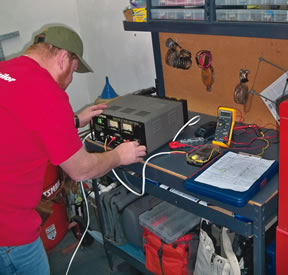
288
Our testing apparatus for our freshwater pump test included a pressure gauge and shut-off valve rigged on an upright board that provided about a 6-foot lift—about the max for boats 40 feet or shorter. The rig has a 3/4-inch outlet with 3/4-inch hose leading down to a calibrated container; this permitted precisely timed runs to determine the actual gallons-per-minute flow. Pumps that offered multiple hose-diameter options were tested using the largest option.
The rig was served on the intake side by both 3/4-inch and half-inch inlets, and electricity was supplied by a CSI Speco 12-volt regulated power source that provided a consistent 13.8 volts DC. Because of the ample power supply, the pumps performed at, near, or sometimes better than their specified GPM ratings. The resulting water pressure is akin to what a user might get with the engine running or boat hooked up to shorepower.
We mounted each pump to a test platform located directly above the supply tank and added crimp-on ring connectors to the factory leads. We then connected them to a fuse panel with properly sized fuses. Two feet of No. 14 wire connected the power supply to the fuse block energizing the pumps, which was then connected to each pump with 6 feet of No. 14 wire. Testers used a Fluke 77/BN multimeter to monitor supply voltage.
The water in the half-inch circuit would flow through the intake hose, take a 360-degree loop, pass through an on/off valve, go straight through a T-fitting to another 90-degree elbow, then through another T-fitting (with pressure gauge attached), through a big on/off valve, and then through one more 90-degree elbow at the output end. The 3/4-inch circuit was similarly designed, but with an extra 90-degree elbow and an extra right angle through the T.
Testers fit the appropriate hoses to each test pump, connected the power, and adjusted the intermediate on/off valves. With the intake hose in a container of water, the pump was run for a few moments to charge the hoses with water. The main valve (at the top of the board) then was shut off, with the pump still ready to deliver. After redistributing the water, the main valve was opened, a stopwatch activated, and flow rate was measured in multiple, one-minute runs.
Pump noise levels were read on a Radio Shack Digital Sound Level Meter placed 1 foot away from each pump, and the amp appetites were noted with a Sears Craftsman 82062 DC/AC clamp-on ammeter.
Although the noise levels listed in the Value Guide on page 15 are not radically disparate, it should be noted that the racket the pumps made on our open, wood test platform is greater than the noise they would make when tucked away in some enclosed compartment on a boat. However, the primary object here was to compare the sound levels in identical circumstances.

288
When measuring power usage, testers took amp readings once the pump had settled down to work on moving the water steadily. At the end of the timed period, the main valve was closed, the amount of water pumped was recorded, and the pressure in the system was taken from the gauge just ahead of the main valve. As in our 2003 test, the pressure in the system (when closed) revealed little other than that there were several tiny leaks that showed up only when the main valve was closed and the pressure very briefly shot up before quickly settling back down.
Pumps were also given pluses for features like adjustable mounts, lengthy power leads, and sturdy connections.
Most test pumps featured an option for some form of “quick connect” input and output ports instead of threaded fittings. However, the Shurflo and Groco pumps used threaded fittings exclusively. In the past, PS has noted that threaded fittings are difficult to make leakproof and that hose clamps are not easy to use. Quick connectors are easy to use and are less likely to leak. However, replacements for them are not readily available everywhere, and we’ve seen some quality-control issues with the plastics used to make them. The slide-lock component on a quick-connect fitting of a Johnson Pump Protector Inlet Strainer pump was recently entered into our Gear Graveyard (January 2011) when it broke after very little use. The thin piece of plastic was clearly not designed for hard use. When it comes to choosing a pump, the pros and cons of durable fittings over easy-to-use fittings should be considered.




































